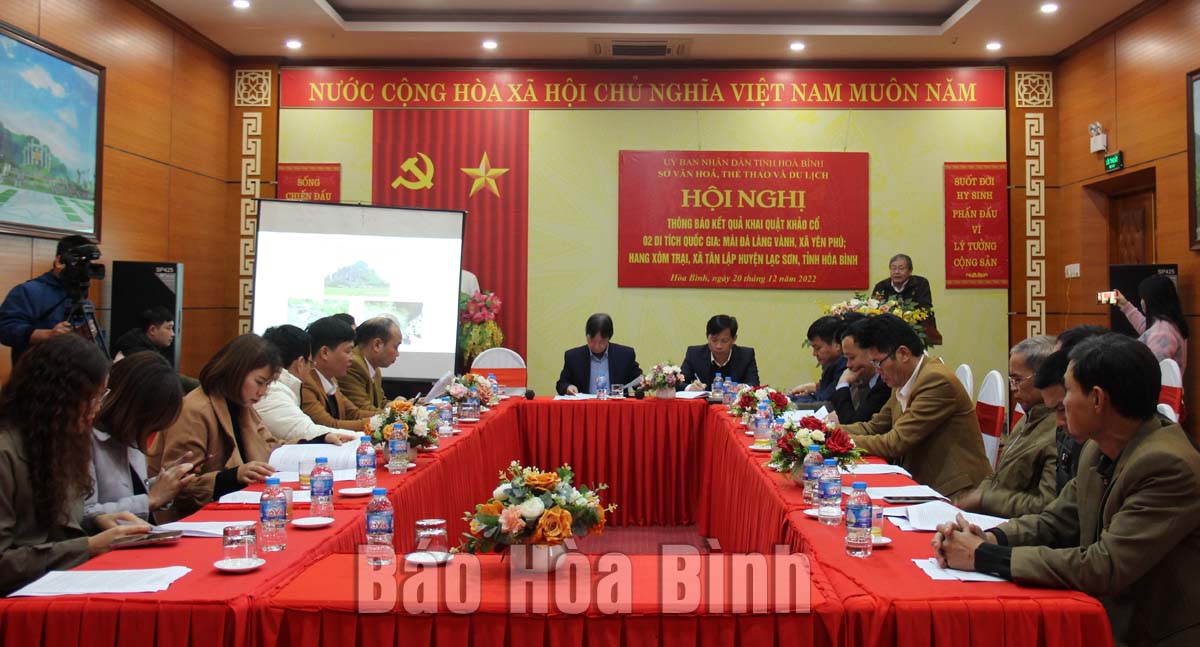
(HBO) - On December 20, the Department of Culture, Sports and Tourism held a conference to announce the preliminary results of archaeological excavations of the two national-level relics, the stone roof of Vanh village in Yen Phu commune and the cave in Trai village in Tan Lap commune (Lac Son). There was attendance of the leaders from the Institute of Archeology, the Center of Prehistory of Southeast Asia, the People's Committee of Lac Son district and the People's Committee of Tan Lap and Yen Phu communes.

Dr. Nguyen Viet, the Director of the Southeast Asian Prehistory Center reported the results of archaeological excavations of the 2 national relics in Trai village and the stone roof of Vanh village (Lac Son).
Implementing Decision No. 1052, dated on May 6, 2022 of the Ministry of Culture, Sports and Tourism on archaeological excavations, the Department of Culture, Sports and Tourism, the Provincial Museum have collaborated with the Institute of Archeology, Vietnam Academy of Social Sciences, the Southeast Asian Prehistory Center to excavate the relics at the national-level relic of the stone roof of Vanh village in Vanh hamlet, Yen Phu commune and the national archaeological site of Trai village in Tan Lap commune (Lac Son). Up to now, the archaeological excavation of the 2 national relics has been completed. The excavation results are a new source of material, contributing to enriching the content of Hoa Binh Culture, making the practical contributions to the work of celebrating the 90th anniversary of its establishment, researching Hoa Binh Culture in Vietnam, honoring the value of cultural heritage, showing gratitude to the French archaeologist, Madeilen Colani, and many generations of the prehistoric researchers, the cultural managers at home and abroad.
The national archaeological relic, the stone roof of Vanh village, the excavation period is from May 15 to October 15, 2022, excavating 4 exploration pits and 1 excavation pit with an area of 39 m2. They have discovered the trace of some fire stoves, the clusters of animal bones and clusters of boulders that may be related to prehistoric people's place for tool-making or food-processing in the stone roof of Vanh village; They did not detect the traces of relics in the pits outside the cave. In the excavation and exploration pits, a large number of relics have been obtained, mainly the stone, bone, pottery and molluscs items; There are 7 more absolute dates for the stone roof relic of Vanh village, after having the results of the correction of the tree ring, it will have the earliest absolute age in this relic up to 25 million years ago from today.
The national archaeological relic in Trai hamlet with excavation period from May 15 to October 15, 2022, excavated 4 pits with a total area of 37 m2. The excavation of the remains of the cultural layer in the village of Trai in the pits H2 and H3, determining the disturbance, the extent of the remaining intact; excavating pits H1 and TS1 outside the adjacent Trai hamlet; obtaining a group of fire stove relics, the millet stone blocks/the blocks used for making stone tools, bones and they are most likely related to the prehistoric man's food processing activities; collecting a large number of samples for the analysis of the absolute dating, petrology, spores and pollen...; collecting a large number of relics, mainly stone, bone and little pottery; there is 1 more absolute date for the cave in Trai village.
At the conference, the delegates proposed and recommended a number of issues such as continuing to carry out research and excavation by micro-document method in order to take samples for analysis of new absolute dating for 2 archaeological sites; developing the registration dossiers for the special national heritage ranking for the 2 relics.
The People’s Committee of Lac Son district held a ceremony on April 28 to receive the provincial relic certificate for the ancient rock carving site at Suoi Co stream, located in My Thanh commune.
A special music show titled "The country is in the fullness of joy” has been held at Hoa Binh Square in Hoa Binh city in celebration of the 50th anniversary of the liberation of the South and national reunification (April 30, 1975–2025).
The People's Committee of Lo Son commune, Tan Lac district, has organised the local annual traditional stream fishing festival on April 19 - 20.
As a land deeply intertwined with human history and Vietnam’s millennia-long journey of nation-building and defence, Hoa Binh is often revered for its epic tales and legends.
Residents of Hoa Binh boast a rich cultural identity, reflected in their unique language, traditional attire, customs, and folk melodies – described as "sweet as honey, clear as a mountain stream.”
Lac Son district’s Vu ban town held the 2025 Truong Kha temple festival on April 12–13 (the 15th–16th days of the third lunar month). Since its revival in 2019, the festival has been organised every three years, preserving valuable intangible heritage while meeting the community’s cultural and spiritual needs.



